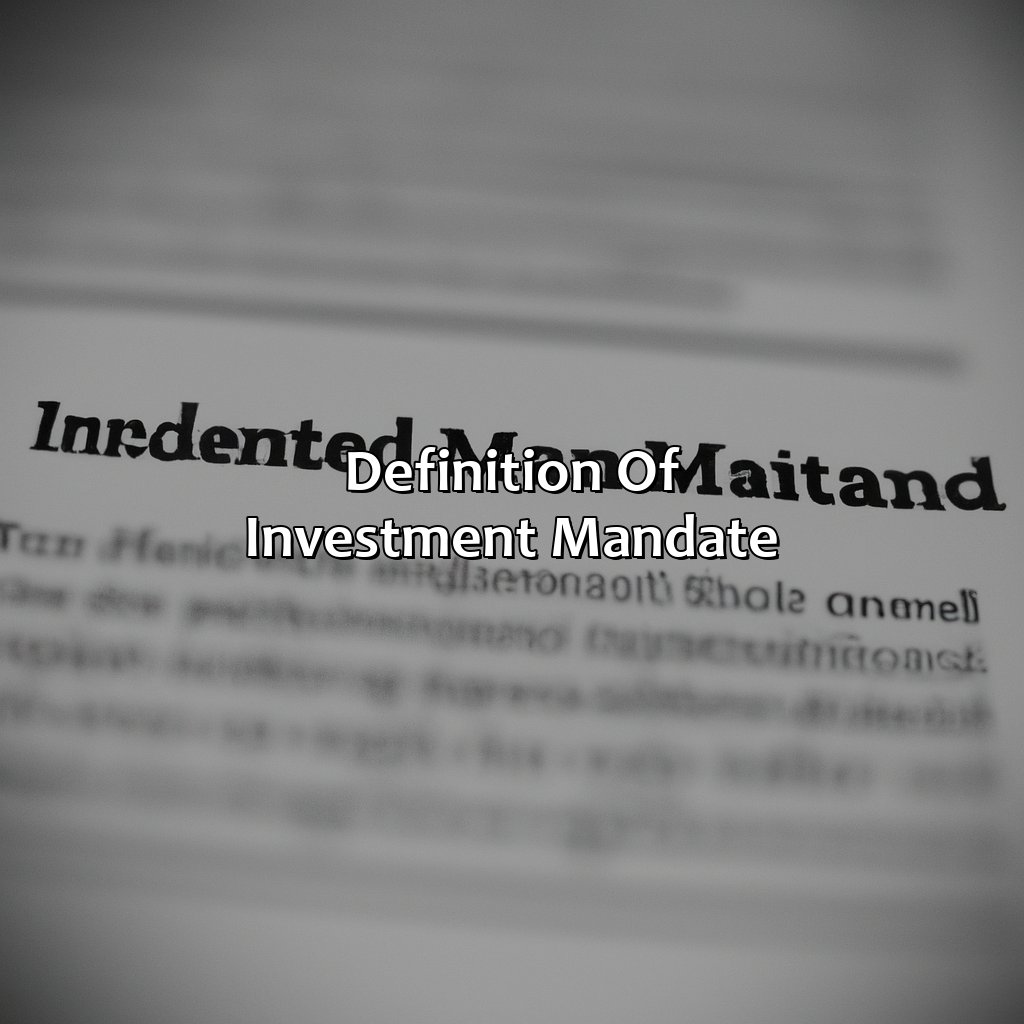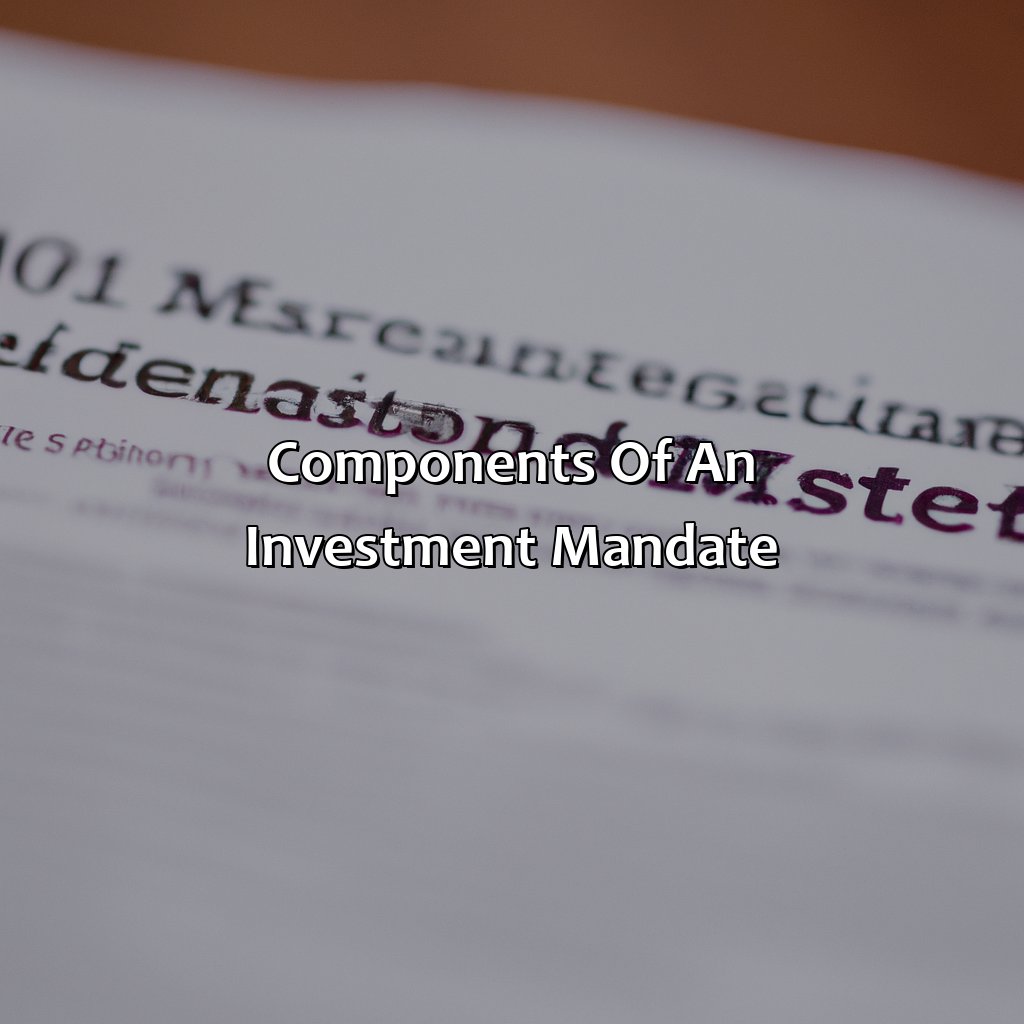What Is An Investment Mandate?
Key Takeaway:
- An investment mandate is a document that outlines the specific goals, guidelines, and restrictions associated with a particular investment strategy.
- The components of an investment mandate typically include investment objectives, guidelines and restrictions, performance benchmarks, and risk management procedures.
- Having a well-defined investment mandate is important because it helps with investment decision-making, provides accountability and transparency, and enables efficient communication with investors.
Are you considering investing your money but don’t know where to start? An Investment mandate is a useful tool to begin managing your finances and making informed decisions. Learn about the benefits of an Investment mandate and how it can help you reach your financial goals.
Definition of Investment Mandate
Investment Mandate is a guided set of instructions that outline an investor’s expectations and preferences in regards to an investment portfolio. It includes information on the investor’s risk tolerance, expected returns, asset allocation, ethical considerations, and other specific investment goals.
By providing this guidance, investment managers use Investment Mandate to build and manage portfolios that help investors achieve their financial objectives. Effective management of Investment Mandate is essential for successful investing and risk mitigation. It enables investors to stay on track with their financial goals and reduces the risk of under-performing portfolios.
Pro tip: Ensure your Investment Mandate is comprehensive and regularly reviewed to align with the changing market conditions.

Image credits: retiregenz.com by Yuval Woodhock
Components of an Investment Mandate
To grasp the components of an investment mandate, break it down into subsections. First, investment objectives clarify the mandate’s goals. Guidelines and restrictions create a framework. Performance benchmarks monitor progress. Lastly, risk management procedures guarantee the mandate remains within acceptable boundaries.

Image credits: retiregenz.com by Adam Washington
Investment Objectives
Investment objectives are the key results that an investor seeks to achieve through an investment mandate. The goals vary depending on the type of investment, risk tolerance of the investor, and available market conditions. These objectives provide a clear direction for investment decisions from portfolio selection to security choices. Without a well-defined objective, it is impossible to measure success or failure.
A comprehensive investment objective should include performance expectations, asset allocation guidelines, and constraints that limit investments. Performance expectation must be tied to a benchmark that reflects the investor’s risk preference. Asset allocation guidelines determine how much money is invested in each asset class such as equity, bonds or cash. Constraints cover all the limiting factors that investors face when investing in securities such as legal restrictions, tax implications and time horizons.
In addition, investment objectives serve as a roadmap for professionals who manage funds or portfolios. They use these objectives to create an investment strategy that aligns with clients’ goals while managing risks efficiently.
According to Forbes [source], 62% of investors fail to meet their financial goals because they lack well-defined investment mandates that clarify their objectives. Hence, setting proper investment mandates from the beginning is critical for achieving better returns and creating long-term wealth.
Guidelines and Restrictions – because sometimes it feels like being an investment manager is more about following rules than making money.
Guidelines and Restrictions
Investment Directive and Limitations are crucial components of an Investment Mandate. The investment objectives of the client and authorized asset classes would determine these guidelines and restrictions. They are put in place to ensure that investments made align with client interests, goals as well as comply with legal and regulatory standards.
- Target Returns
- Risk Tolerance
- Liquidity Constraints
- Geographical Restrictions
- Asset Class Restrictions
These limitations guide the allocation of resources for better investment decisions. It is successively an intrinsic part of creating a well-defined investment mandate, which favors long-term strategies in comparison to ad-hoc investment decisions.
Investment Mandates incorporate these directives to establish precisely how the client’s capital will be preserved. With a well-defined investment strategy, limitations can add further definition on executing the overall goal of generating above returns while managing risk. Bonds’ ability to generate decent returns with limited risk has been observed throughout history. This was seen during times such as World War II when citizens had no choice but to invest their money in war bonds.
The Investment Mandate constraints play a critical role in determining where funds go and how they get there. These restrictions protect against rash decisions, providing reassurance that returned options met customer expectations while staying within set compliance controls.
Grab a seat, Performance Benchmarks are where investors come to either feel really good or really bad about themselves.
Performance Benchmarks
Performance benchmarks serve as a measurement tool to assess the success of an investment strategy. These indicators are crucial for evaluating the performance of funds, asset managers and other investment opportunities. They provide accurate data on rate of returns, market value analysis and volatility metrics.
The use of performance benchmarks ensures that investment mandates align with targets set out in the strategy. Often times, these benchmarks are determined by economic cycles, domestic policies or global trends. Investors use this analysis to adjust their portfolios according to changing conditions.
It is important to note that there is no single benchmark that applies to all investments as each one has its unique characteristics and goals. Therefore, investors choose a combination of indices that closely represents their investment’s portfolio objectives.
Using benchmarks may require careful consideration in selecting the right ones since they can have limitations such as having restrictive structures or be heavily influenced by economic factors beyond reasonable control.
A good example is Vanguard Group’s S&P 500 exchange-traded fund (ETF). It tracks U.S large-cap stocks but fails to measure up well against small-cap indexes proving differentiating factors exist even within seemingly similar asset classes.
Risk management is like sunscreen for your investments – you hope you won’t need it, but it’s important to have just in case.
Risk Management Procedures
The investment mandate requires well-thought-out risk control approaches to ensure successful investing. The set of measures put in place to handle the uncertainty that comes with investments are known as Risk Management Procedures. These procedures include asset selection, portfolio diversification, and investment screening.
Proper documentation of various investment risks provides a comprehensive overview of possible outcomes within an investment cycle. Understanding the volatility, liquidity, and market-related risks is paramount to evaluate equity instruments, maintain portfolio balance, and protect against potential losses. In addition to that, customized investment mandates also take into consideration operational risk associated with personnel management and data security.
Investment managers should execute these procedures through continuous research and analysis by leveraging both quantitative and qualitative methods for assessment. This ensures dynamic integration of new strategies while correctly calibrating traditional procedures on current market trends.
In one scenario, a hedge fund manager responsible for a sizable portion of the company’s assets exceeded the assigned leverage limit due to an unnoticed risk exposure in his investments. As a result, he was asked to exit all his positions immediately resulting in huge losses for the firm. Had the team been following their defined Risk Management Procedures more accurately, this situation could have been avoided.
Without an investment mandate, your portfolio is like a ship without a rudder – lost at sea, with no direction or purpose.
Importance of Investment Mandate
Comprehending the importance of an investment mandate is vital. To assist in making smart decisions, this section highlights its importance. It includes sub-sections such as:
- Helps with Investment Decision-making
- Provides Accountability and Transparency
- Enables Efficient Communication with Investors
Knowing the advantages it offers will give a wider understanding.

Image credits: retiregenz.com by Adam Woodhock
Helps with Investment Decision-making
Crafting a well-defined investment mandate is crucial as it facilitates the decision-making process. It ensures that every investment move aligns with the objectives and goals of the investor, helping them make informed decisions while mitigating risks. A well-thought mandate includes details on asset allocation, benchmarks, risk management, and investment horizon, which further helps investors stay within their comfort level and invest wisely.
Moreover, an investment mandate acts as a guidebook for portfolio managers so they can ensure investments align with both the investor’s goals as well as their own objectives. When investors have set clear expectations through a mandate, portfolio managers can then tailor their strategies to meet these requirements, ultimately resulting in long-term success.
A thoughtfully crafted investment mandate sets forth measurable parameters that assist investors in staying focused towards fulfilling their financial goals. This involves setting targets and determining when to withdraw from or add to certain investment positions. By keeping themselves accountable to these predetermined parameters, investors can evaluate overall progress regularly.
According to Morningstar’s 2019 Global Investor Experience Report, most mutual funds do not offer clear mandates for investors’ guidance. Thus, because of their importance in making informed decisions, investors must define them before starting any investment journey.
If only my ex had an investment mandate, maybe I wouldn’t be living off instant ramen and regret.
Provides Accountability and Transparency
One of the significant advantages of an investment mandate is that it fosters accountability and transparency. The mandate guides the fund manager’s investment decisions, ensuring they adhere to the fund’s objectives and limitations. It provides a transparent framework for investors to identify whether their investments align with the mandate.
Apart from offering a clear set of guidelines for asset allocation, risk management, and performance measurement, an investment mandate ensures stakeholders understand how their investments are managed. This transparency cultivates trust and confidence in the fund management team as investors can see how their money is working.
Moreover, investment mandates help prevent conflicts of interest between fund managers and investors. Any deviation from the agreed-upon criteria can raise red flags that spark discussion on financial goals versus actual performance. As such, every actor in the investment process plays by clearly established and mutually agreed-upon rules.
A study by PwC reveals that over 35% of investors have shifted money away from companies or funds that do not meet their environmental, social or governance (ESG) standards. A clearly articulated investment mandate can help justify ESG investments to stakeholders interested in sustainable finance practices.
Enables Efficient Communication with Investors
An investment mandate is crucial in streamlining communication with investors, enabling efficient exchange of information and expectations. Providing a clear, concise definition of the investment goals and policies fosters transparency, accountability and trust between fund managers and investors. It eliminates potential misunderstandings and avoids wasted time and resources in managing investor questions.
Investment mandates are comprehensive instructions that detail the criteria for selecting investments, asset allocation strategies, risk management guidelines, and reporting procedures. They offer insights into investor preferences, ethical considerations, liquidity needs, limitations on portfolio composition, among others. By outlining these parameters upfront, managers can align their investment approach with the investor’s objectives while providing a tailored service.
Moreover, Investment mandates serve as a benchmark for assessing performance against set targets allowing investors to evaluate the success of their investment over time consistently. It also identifies risks early warning signs that can impact returns if not managed effectively.
Fund managers should draft an investment mandate that meets their investors’ specific needs while also being flexible enough to respond adequately to dynamic market conditions. A well-designed Investment Mandate will help attract new clients by demonstrating professionalism and expertise during prospecting opportunities; however more importantly helps keep existing investors retained thanks to the ease of communication that comes with it.
Overall understanding of these nuances represents just part of what makes up being an accomplished fund manager who is focused on delivering excellent results while staying true to your client’s goals via efficient communication enabled by a well-drafted Investment Mandate.
Five Facts About Investment Mandate:
- ✅ An investment mandate is a set of guidelines or rules that govern how an investment manager must manage an investor’s portfolio. (Source: Investopedia)
- ✅ The purpose of an investment mandate is to ensure that the investment manager’s actions align with the investor’s goals and objectives. (Source: The Balance)
- ✅ An investment mandate can be broad or specific in scope, depending on the investor’s preferences and needs. (Source: Morningstar)
- ✅ Investment mandates can include various types of investments, such as stocks, bonds, real estate, and commodities. (Source: Forbes)
- ✅ Investment mandates can also include restrictions on certain types of investments or industries, such as ethical or socially responsible investing. (Source: The Guardian)
FAQs about What Is An Investment Mandate?
What is an investment mandate?
An investment mandate is a set of guidelines that an investor or fund manager follows to make investment decisions. It outlines the investor’s objectives, risk tolerance, and preferred asset classes, and it may also specify any legal or regulatory requirements.
Why is an investment mandate important?
An investment mandate is important because it helps investors and fund managers make informed decisions that align with their objectives. It also serves as a benchmark for measuring investment performance and provides a framework for managing risk.
What are the components of an investment mandate?
An investment mandate typically includes the following components: investment objectives, investment guidelines, risk tolerance, asset allocation, investment restrictions, legal and regulatory requirements, and reporting requirements.
How is an investment mandate determined?
An investment mandate is determined through a combination of investor preferences, market conditions, risk exposure, and legal and regulatory requirements. It may evolve over time as the investor’s objectives or the market landscape changes.
What types of investors use an investment mandate?
An investment mandate is commonly used by institutional investors, such as pension funds, endowments, and foundations, as well as high net worth individuals and family offices. It may also be used by fund managers to guide their investment decisions on behalf of clients.
What are some examples of investment mandates?
Examples of investment mandates include socially responsible investing (SRI), in which investors seek to align their investments with their values and social objectives, or quantitative investing, in which investment decisions are based on statistical models and algorithms rather than human judgment.
